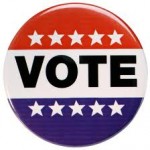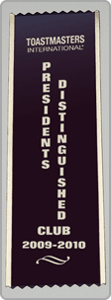 As many of you probably know, the U.S. elections were a few weeks ago. As a candidate myself, albeit for a rather different sort of office, I viewed the TV ads with a different eye than two years ago.
As many of you probably know, the U.S. elections were a few weeks ago. As a candidate myself, albeit for a rather different sort of office, I viewed the TV ads with a different eye than two years ago.
Some were good issues-oriented ads, extolling the virtues and experience of the candidate. Unfortunately, the major political races in Illinois degenerated into mud-slinging, with ads about the opponent concluding with words like “Who IS this guy?” in a deep and worried voice.
I’m quite glad that our campaign policies prohibit that sort of mess. We keep campaigns positive and constructive, just like our speech evaluations. Candidates talk about what they bring to the table, not what the opposition lacks. I talk about my skills in strategic planning, my experience in Toastmasters, my passion for the organization. It’s up to the voters to decide who the better candidate is, based on what they say — or don’t say.
I served as a Chicago election judge several times, and it was an interesting and fun experience in democracy. Judges had to be at the polls by 5 AM so we could open at 6 AM, and the polls closed at 7 PM, with our duties completed around 8 PM — a 15 hour day. Since turnout was light, I spent most of the day sitting and chatting with the other judges. In a typical precinct of about 1000 voters, you might get 150 of them in an off-year election, or maybe 300 in a presidential election. Spread over that long day, the four of us weren’t very busy, other than the before-work and after-work crunch.
Knowing that all those other eligible voters didn’t bother to vote was depressing, never mind those who didn’t even register. I’ve heard people say that they dislike all the candidates, so they don’t vote, or that their vote won’t matter out of thousands or millions.
We face a voter turnout problem in Toastmasters as well. In a post I made soon after the August 2010 convention, I noted that while most districts returned over 70% of the club ballots, six were under 50% and one was just 14%. While some clubs may not really know or care how the organization is run (until it comes to dues!), districts should know and should care, and should work hard to collect those proxies and cast them as they see fit, whether for a governance proposal or for candidates.
There are many opportunities to get to know our candidates in a positive way — through their web site, social media fan pages, e-mail, phone calls, the candidates’ showcase at the convention, and individual interviews. (No TV or radio ads though!) Where possible, talk to people who have worked with the candidate and find out their experiences with the candidate in real-world leadership roles — while we can judge the World Champion of Public Speaking in 5-7 minutes, judging leadership is something that takes months or years.
Collecting club proxies can be a great High Performance Leadership project, which is often the last thing members do on the road to a DTM. Start looking now for someone who would be interested in doing this, and let’s get every district up to at least 80% of clubs represented. They’ll need to recruit a committee with representatives in every division (and maybe every area) to reach out to clubs, and that takes time. This might be done by the Area or Division Governors, but since this isn’t a core part of the AG or DivG’s mission, would be better done by someone else (maybe a past or future AG/DivG!).
Let’s make sure every club is represented in Las Vegas in August 2011!







